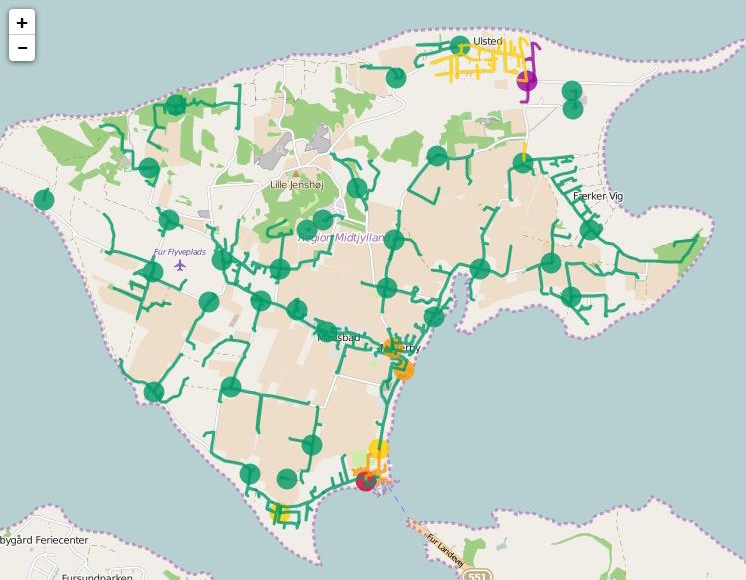Sep 28 2016
The GreenCom project, funded in part by the European Commission and led on the technical side by Fraunhofer FIT, ended after 42 months, judged a resounding success. The project's main result is a Smart Energy Monitoring and Control system for load management of regional power grids. A test environment comprising 29 homes on the Danish island Fur integrates heat pumps, photovoltaic systems, batteries and smart-home installations.
 Load distribution in the Fur grid. Colors represent the load levels on power lines and transformer stations: Green stands for optimal load, Red for very high and Purple for critically high load situations. (Photo Credit: Fraunhofer FIT)
Load distribution in the Fur grid. Colors represent the load levels on power lines and transformer stations: Green stands for optimal load, Red for very high and Purple for critically high load situations. (Photo Credit: Fraunhofer FIT)
The growing share of renewable energy sources leads to wider load fluctuations in power grids, necessitating new concepts and ways to avoid overload. What is needed is a flexible smart grid able to adjust to the fluctuations in the production and the consumption of electricity. Here, the GreenCom project focused on regional smart grid solutions that may help to avoid or minimize the need for grid expansion on the national level.
The aim was to detect potential instabilities in power grids by monitoring and forecasting how much power will be generated and consumed in the households attached to the grid. On the basis of forecasts and real-time data the GreenCom system can take load-balancing measures on a regional level, allowing for an improved balance of supply and demand.
The GreenCom project implemented a realistic test environment: On the Danish island Fur we worked with the local grid operator to install the "Smart Energy Monitoring and Control System" in 29 homes. The system can capture, aggregate and analyze, almost in real-time, data on devices, sensors, actuator and smart meters in individual homes. Heat pumps, photovoltaic systems and batteries are attached to the system, but also the smart-home installations built by Fraunhofer FIT.
"The smart energy management system developed in the GreenCom project is a control platform that will significantly improve energy management. It is particularly well suited to smart cities and similar local communities", says Dr. Markus Eisenhauer, head of the User-Centered Computing department of the Fraunhofer Institute for Applied Information Technology FIT.
The data analysis provides consumption data for different types of devices and locations as well as short-term forecasts (for up to 4 hours). This allows planning load-balancing measures. Large-scale power consumers in the homes are switched on at different times to avoid peak loads in the grid.
The forecasts and consumption data collected in the project were also used to analyze existing business models and develop new ones. The latter may feature a novel player in the market, which we call "aggregator". Aggregators offer heating as a service: Homeowners allow their heat pumps to be controlled remotely and in exchange pay less for heating their homes. The contracts specify an acceptable temperate range. Thus the aggregator has some flexibility in reacting to fluctuating electricity supply and can sell this flexibility to the grid operator. This might be a model for controlling the electricity consumption of residential houses in the future. The owners would only have to accept that the heat pump is under external control, without making any compromises in terms of heating comfort or usage pattern, as heat pumps do not have to work continuously and can be controlled remotely without any negative effects on the people living in the house. Here, reduced heating costs may be a convincing economic argument. If this model actually works on a broader scale remains to be seen in the coming years.
The GreenCom project, funded in part by the European Commission in the 7th Framework Programme for Research and Technological Development, was coordinated by the Italian Istituto Superiore Mario Boella (ISMB). Besides Fraunhofer FIT, the project consortium included the Danish partners EnergiMidt A/S, Actua A/S, Tyndall National Institute and In-JeT ApS as well as Sensing & Control Systems (Spain) and University College Cork (Ireland).